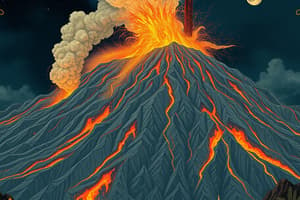Podcast
Questions and Answers
What did Charlie Crisafulli and another ecologist spot as the first plant on Mount St. Helens?
What did Charlie Crisafulli and another ecologist spot as the first plant on Mount St. Helens?
- A fern plant
- A daisy flower
- A cedar tree
- A lone lupine plant (correct)
Why were lupines able to colonize the barren landscape on Mount St. Helens despite the poor nutrient availability in the volcanic ash?
Why were lupines able to colonize the barren landscape on Mount St. Helens despite the poor nutrient availability in the volcanic ash?
- Lupines could grow without sunlight
- Lupines could fix nitrogen, enriching the soil (correct)
- Lupines could resist extreme temperatures
- Lupines could absorb nutrients from the volcanic ash
What did the lupine plants physically trap, contributing to the enrichment of the soil?
What did the lupine plants physically trap, contributing to the enrichment of the soil?
- Water
- Windblown debris (correct)
- Birds
- Sunlight
How did insects contribute to enriching the soil around the lupine plants?
How did insects contribute to enriching the soil around the lupine plants?
What did Crisafulli learn as one of the key lessons of succession from observing the lupine wildflowers?
What did Crisafulli learn as one of the key lessons of succession from observing the lupine wildflowers?
What was observed to be transported by a log carried downstream in a mudflow to areas devoid of organisms according to Crisafulli's observations?
What was observed to be transported by a log carried downstream in a mudflow to areas devoid of organisms according to Crisafulli's observations?
What term is used to describe the remnants of old landscape that serve as source populations for species to recolonize a disturbed area?
What term is used to describe the remnants of old landscape that serve as source populations for species to recolonize a disturbed area?
What did scientists at Mount St. Helens discover about the influence of biological legacies on plant and animal communities after the eruption?
What did scientists at Mount St. Helens discover about the influence of biological legacies on plant and animal communities after the eruption?
Why is it now understood to be important to leave some live and dead trees during harvesting in areas affected by disturbances like eruptions?
Why is it now understood to be important to leave some live and dead trees during harvesting in areas affected by disturbances like eruptions?
What is the role of red alder trees in post-eruption succession at Mount St. Helens?
What is the role of red alder trees in post-eruption succession at Mount St. Helens?
What changes have occurred in the vegetation of the blast area 30 years after the eruption?
What changes have occurred in the vegetation of the blast area 30 years after the eruption?
How long are scientists predicting it will take for the blast area to resemble its pre-eruption state?
How long are scientists predicting it will take for the blast area to resemble its pre-eruption state?
Flashcards are hidden until you start studying




